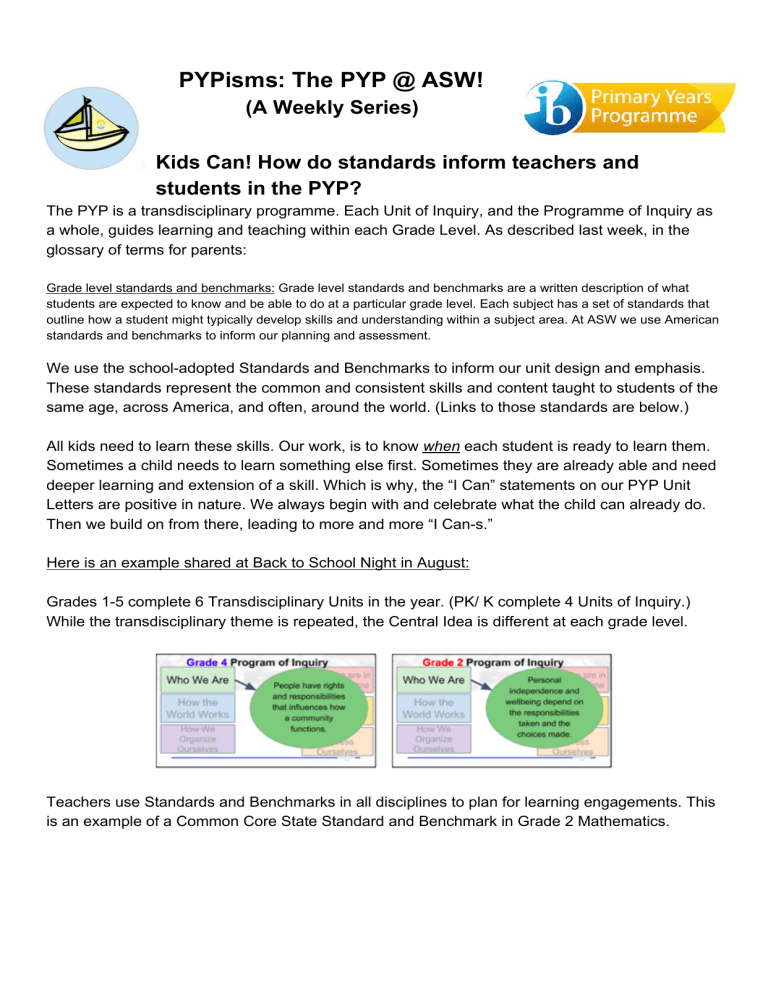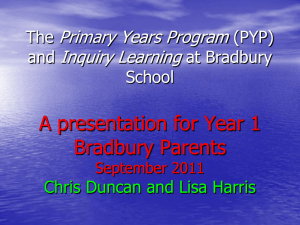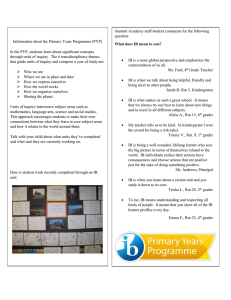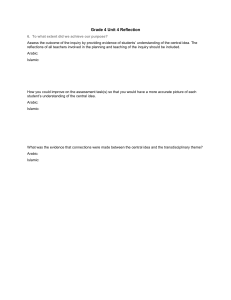
PYPisms: The PYP @ ASW! (A Weekly Series) Kids Can! How do standards inform teachers and students in the PYP? The PYP is a transdisciplinary programme. Each Unit of Inquiry, and the Programme of Inquiry as a whole, guides learning and teaching within each Grade Level. As described last week, in the glossary of terms for parents: Grade level standards and benchmarks: Grade level standards and benchmarks are a written description of what students are expected to know and be able to do at a particular grade level. Each subject has a set of standards that outline how a student might typically develop skills and understanding within a subject area. At ASW we use American standards and benchmarks to inform our planning and assessment. We use the school-adopted Standards and Benchmarks to inform our unit design and emphasis. These standards represent the common and consistent skills and content taught to students of the same age, across America, and often, around the world. (Links to those standards are below.) All kids need to learn these skills. Our work, is to know when each student is ready to learn them. Sometimes a child needs to learn something else first. Sometimes they are already able and need deeper learning and extension of a skill. Which is why, the “I Can” statements on our PYP Unit Letters are positive in nature. We always begin with and celebrate what the child can already do. Then we build on from there, leading to more and more “I Can-s.” Here is an example shared at Back to School Night in August: Grades 1-5 complete 6 Transdisciplinary Units in the year. (PK/ K complete 4 Units of Inquiry.) While the transdisciplinary theme is repeated, the Central Idea is different at each grade level. Teachers use Standards and Benchmarks in all disciplines to plan for learning engagements. This is an example of a Common Core State Standard and Benchmark in Grade 2 Mathematics. In the PYP at ASW, we use the “I Can” version of that standard to ensure students understand what they can do and what they need to do next. Most importantly, we find out where each child is with this skill. Some will not yet be able to do this and will need to work on something else. Others will be almost doing this and will need more practice. Some will be already doing this skill and will need to be challenged to develop deeper understanding. We meet every child where they are in relation to the Standards and Benchmarks and move them forward. Links to ASW K-12 Core Curriculum Standards and Benchmarks: Common Core State Standards in Language Arts and Mathematics AERO Standards in Science and Social Studies Next Week: Social-Emotional Learning in the PYP: Digital Citizenship and Technology Use PYP Terms for Reference for Parents: Programme of Inquiry: The PYP is structured around six Transdisciplinary Themes that make a school’s programme of inquiry (POI); within these themes at each grade level, students explore Units of Inquiry that promote investigation and critical thinking. All PYP schools worldwide have the same six transdisciplinary themes. Units of Inquiry: A unit of inquiry is a deep exploration of a big idea within a transdisciplinary theme. Students will inquire into 4-6 units of inquiry in a grade level. Units of inquiry give a framework to mathematics, language, science, social studies, art, PE, music, Polish mother tongue, French as an additional language, Polish culture and language as well as social and emotional learning. Students use knowledge, skills and understanding of different subjects to deepen their understanding of the big ideas within the Unit of inquiry. Central Idea Each PYP Unit of Inquiry has a Central Idea. The Central Idea is one sentence that supports students’ understanding of a Transdisciplinary Theme. These Central Ideas are the focus of learning within a Transdisciplinary Theme at a particular grade level. Teachers have created the Central Ideas at ASW from our grade level standards and benchmarks and examples from other PYP schools around the world. Central Ideas are open and broad enough that there are different ways to learn about this big idea. Lines of Inquiry: Lines of Inquiry give teachers and students a specific learning focus. Each Unit of Inquiry has 2-4 Lines of Inquiry that define the direction of the Unit of Inquiry. Lines of Inquiry clarify how the Central Idea will be explored at a grade level. Understanding of these Lines of Inquiry is assessed throughout the Unit of Inquiry. Concepts: Concepts are big ideas that are universal, timeless, abstract and transfer across subject areas. The PYP is a concept-based curriculum framework. Learning is organized through eight PYP Key Concepts which include: Form, Function, Connection, Causation, Change, Perspective, Responsibility and Reflection. Each Unit of Inquiry includes 2-3 Key Concepts that connect with the Lines of Inquiry and make sense in relation to the Central Idea. In each grade level, all eight PYP Key Concepts are explored within different Units of Inquiry. There are also Related Concepts within Units of Inquiry. These align with the PYP Key Concepts but are usually more subject specific, for example Migration, Imagination or Conflict. ATLs: The Approaches to Learning (ATLs) are broad groups of skills that can be developed and practiced across all subject areas. They include a variety of specific skills organized into thinking, research, communication, self-management and social skill sets. ATLs are identified, taught and assessed within a Unit of Inquiry. These skills are revisited every year in the PYP. ATLs are also planned for, and assessed, in the Middle Years Programme (MYP) and the Diploma Programme (DP) at ASW. Learner Profile: The Learner Profile is a set of attributes that define an internationally-minded person. The attributes of the Learner Profile include: Caring, Thinker, Principled, Knowledgeable, Inquirer, Communicator, Open-minded and Reflective. These attributes are developed over time in the PYP, MYP and DP and form the center of all the IB curriculum frameworks.


